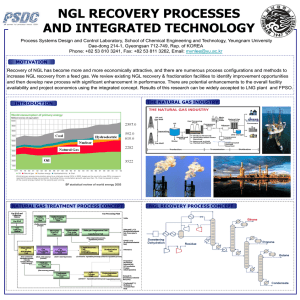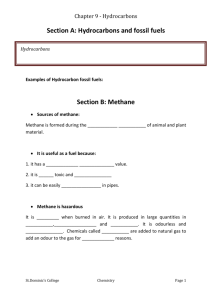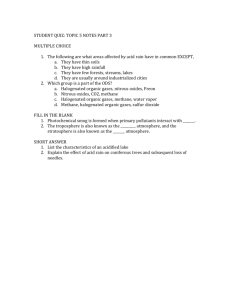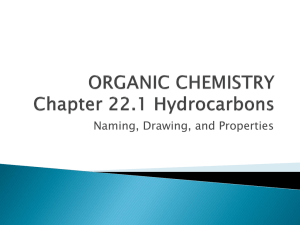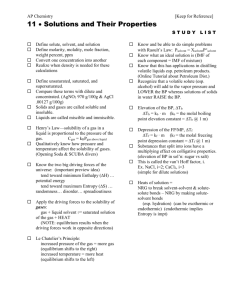natural gas liquids (ngl)
advertisement
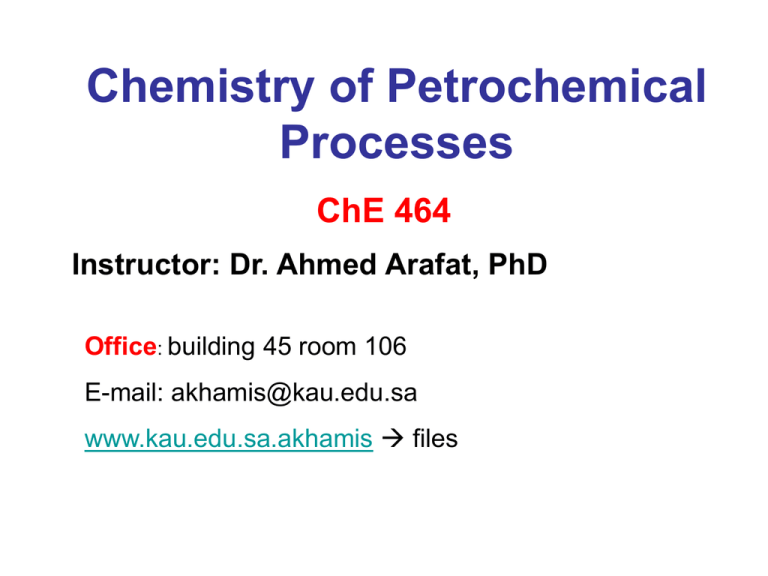
Chemistry of Petrochemical Processes ChE 464 Instructor: Dr. Ahmed Arafat, PhD Office: building 45 room 106 E-mail: akhamis@kau.edu.sa www.kau.edu.sa.akhamis files Book Chemistry of Petrochemical Processes Second Edition Sami Matar Lewis F. Hatch Grading • • • • Presence: Major Exams = 2 x 15% = Quizzes: 2 x 10% = Final Exam= 10 % 30 % 20 % 40 % Chapter One Primary raw materials for petrochemicals Primary raw Materials for Petrochemicals a- Natural gas b- Crude oil Secondary raw Materials for Petrochemicals -Obtained from natural gas or crude oil by different processing schemes - It can be: -Light hydrocarbon compounds (Methane or Ethane) - Heavy hydrocarbon mixtures (naphtha or gas oil (crude oil fractions) Natural Gas Naturally occurring light hydrocarbons (gases) + some non hydrocarbon compounds. Types Non-associated dry well no oil associated on top or dissolved in crude oil Composition: In principal methane + C2— C7 hydrocarbons in very small amounts The amount of higher hydrocarbons changes considerably with the field In non-associated gas fields high % of methane In associated gas fields high % of C2 – C7 Non-hydrocarbons: weak acids e.g. H2S & CO2 Inert gases, e.g. N2, He and Ar Some natural gas reservoirs contain enough He for commercial production. C2 – C7 important fuels produced in the liquid form e.g. ethane used as a feedstock for steam cracking to ethylene Propane + butane sold as liquified petroleum gas (LPG) Natural gas treatment process Disadavantages of acid gases: - H2S is poisonous and corrosive - CO2 reduces the heat value of the fuel and solidifies under transportation conditions (high pressure and low temperature). Therefore, removal of these harmful gases is necessary Acid gas treatment (Removal) 1- Physical absorption using a selective absortion solvent 2- Physical adsorption by solid adsorbent 3- Chemical absorption (Chemisorption) Physical Absorption Known Processes: A- Selexol B- Sulfinol C- Rectisol Characteristics: - No reaction occurs between the acid gas and solvent - Using a solvent which selectively absorb the acid gas Selexol: - Raw natural gas passes counter-currently to the descending solvent. - When the solvent becomes saturated with the acid gases, the oressure is reduced , H2S and CO2 are desorbed - The solvent is recycled to the absortion Tower The selexol process for acid gas removal (1) Absorber (2) flash drum (3) compressor (4) low-pressure drum (5) stripper (6) cooler Physical Adsorption Molecular sieves zeolites are used as adsorbents: Adsorb large amounts of gases and water Zeolite molecular sieves are microporous aluminosilicate compounds able to make adsorption of moleules, some hydrophilic types such as 13X are capable of absorpting water molecules. More than one adsorption beds are used for alternate adsorption and regenration (by hot dry fuel gas) Only used when the amount of acid gasses are low Chemical Adsorption - Used in case of large amounts of acid gases - A solution of weak base is used (monoethanol amine) - The acid gases are removed via the formation of weak bonds with the base solution. - These bonds can easily be destroyed and the base solution can easily be regenerated. - Mono- and diethanol amines are normally used. With which natural gas reacts to form carbonates and sulphides. - Diethanol amine is favored due to its low corrosion rates - Diglycolamine is another amine solvent used in the econamine process shown below. The econamine process: (1) absorption tower (2) Regeneration tower In this process: - Acid gases are absorbed in an absorber containing an aqueous solution of diglycolamine (DGA), and the heated saturated acid gas solution is pumped to the regenerator. - Diglycolamine solution has low freezing point and can be used in areas with cold climates. - Solutions of strong bases are not frequently used as they form stable salts that is not easily separated. CO2 + 2 NaOH Na2CO3 + H2O H2S + 2 NaOH Na2S + 2 H2O However, strong caustic solution is used to remove mercaptans (R—SH) from the gas and liquid streams in The Merox Process • A caustic solution containing cobalt catalyst is used to convert mercaptans (RSH) to RSSR (disulphide). • Air is used to oxidize the mercaptans to disulphides. (R-S-S-R) • The caustic solution is then recycled for regeneration. • It is mainly used for treatment of refinery gas streams. Water Removal Moisture cause corrosion and form hydrates. Water + hydrocarbons hydrates (white compounds) (conditions: high pressures and low temperatures during transportation) Disadvantages Reduce the pipeline efficiency Prevention: treatment with glycols such as: Ethylene glycol (EG), Di EG (DEG) and Tri EG (TEG) Alternative ways: 1- Injection of methanol: Lowering of the hydrate formation temperature below ambient. 2- Employing of solid adsorbents such as molecular sieves. Condensable hydrocarbon recovery C2-- C7 hydrocarbons are valuable fuels. It can be recovered by weak oil extraction. By cooling the treated gas by exchange with liquid propane. The cooled gas is then washed with a cold hydrocarbon liquid, which dissolves most of the condensable hydrocarbons. The uncondensed gas is dry natural gas and is composed mainly of methane with small amounts of ethane and heavier hydrocarbons. The condensed hydrocarbons or natural gas liquids (NGL) are stripped from the rich solvent, which is recycled. NATURAL GAS LIQUIDS (NGL) Natural gas liquids (condensable hydrocarbons): heavier than methane in the natural gas. High in associated gas. Fractionated to separate them into: 1. An ethane-rich stream, which is used for producing ethylene. 2. Liquefied petroleum gas (LPG), which is a propane-butane mixture. 3. Natural gasoline (NG) is mainly constituted of C5 + hydrocarbons and is added to gasoline to raise its vapor pressure. NGL contain significant amounts of cyclohexane, a precursor for nylon 6 Recovery of cyclohexane from NGL by conventional distillation is difficult and not economical because heptane isomers are also present which boil at temperatures nearly identical to that of cyclohexane. An extractive distillation process has been recently developed instead. 1- Another way to recover NGL is through cryogenic cooling to very low temperatures (–150 to –180°F), by adiabatic expansion of the inlet gas. 2- First, remove water and acid gases, then cooled via heat exchange and refrigeration. Further cooling of the gas is accomplished through turbo expanders, and the gas is sent to a demethanizer to separate methane from NGL. 3-Improved NGL recovery could be achieved through better control strategies and use of on-line gas chromatographic analysis. Natural gas liquids may contain significant amounts of cyclohexane, a precursor for nylon 6 (Chapter 10). Recovery of cyclohexane from NGL by conventional distillation is difficult and not economical because heptane isomers are also present which boil at temperatures nearly identical to that of cyclohexane. An extractive distillation process has been recently developed by Phillips Petroleum Co. to separate cyclohexane Liquefied Natural Gas (LNG) After the recovery of natural gas liquids, sweet dry natural gas may be liquefied for transportation through cryogenic tankers. Further treatment may be required to reduce the water vapor below 10 ppm and carbon dioxide and hydrogen sulfide to less than 100 and 50 ppm, respectively. Two methods are generally used to liquefy natural gas: the expander cycle and mechanical refrigeration. In the expander cycle, part of the gas is expanded from a high transmission pressure to a lower pressure. This lowers the temperature of the gas. Through heat exchange, the cold gas cools the incoming gas, which in a similar way cools more incoming gas until the liquefaction temperature of methane is reached. Figure 1-5 is a flow diagram for the expander cycle for liquefying natural gas
